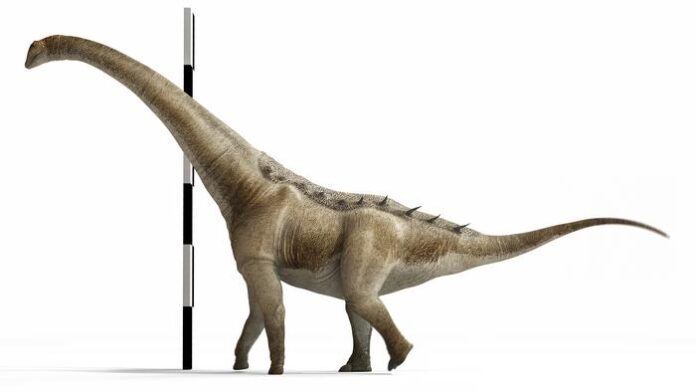A large and unique discovery in Spain reveals how sauropods may have dispersed across Asia and Europe before dinosaurs went extinct.
The well-preserved bones of the newly named Qunkasaura have improved paleontologists’ knowledge of dinosaurs in Europe during the Late Cretaceous.
“Qunkasaura was one of the most outstanding specimens in our quarry,” says Pedro Mocho, a paleontologist at the University of Lisbon in Portugal.
How Was Qunkasaura Discovered?
(Credit: GBE-UNED) General view of the Lo Hueco site during the excavation of Qunkasaura in 2007
Qunkasaura was first discovered by accident, like many dinosaur bones. In 2007, workers were excavating near the Spanish city of Cuenca while building a railway for a high-speed train line connecting Valencia and Madrid. The area around Cuenca was never considered important for paleontology, Mocho says, but workers dug deep enough that they revealed a layer containing fossilized bones.
Paleontologists discovered more than 10,000 bones, including those of dinosaurs, ancient turtles, and crocodiles. The dinosaurs included several sauropod remains, including those of what appeared to be a unique species.
“What was astounding was to find so many sauropods,” Mocho says.
Read More: What Are Fossils and Where Are They Found the Most?
What Was Qunkasaura Like?
A large number of bones from a single individual revealed a lot about what Qunkasaura was like. Paleontologists discovered most of the pelvis, vertebrae from the trunk and tail, some ribs, neck fragments, and parts of the femur and fibula.
“Everyone remembered the specimen because it was beautiful to see in the field,” says Mocho, who was not part of the excavation team but later helped describe the species in a study published recently in Communications Biology.
Mocho and his colleagues’ analysis revealed that the sauropod would have been 32-50 feet from head to tail, weighing around 11 tons.
“It’s not a particularly big sauropod, but much bigger than we generally find in this context,” Mocho says.
Read More: How Scientists Reconstruct What Dinosaurs Looked Like
What Makes Qunkasaura Unique?
The bones dated to around 73 million years ago, during the Late Cretaceous Epoch. At this time, Spain and the rest of Europe were divided into a series of islands.
In an ecological sense, this meant that most of the sauropods — and dinosaurs in general in this area— were quite small, having adapted to less resource availability on smaller islands, Mocho says.
In this context, Qunkasaura is quite large compared to the other sauropods found in Spain and the rest of Europe dating to this period. Many sauropods there belonged to the Lirainosaurinae group, which evolved in Europe around 20 million years earlier.
But, aside from the relatively larger size, Qunkasaura had tail vertebrae that were shaped differently from Lirainosaurinae. They looked a lot more like South American titanosaurs than European — leading the researchers to think this specimen was related to those on that continent. A closer look revealed that Qunkasaura was different in other important ways — it likely adapted vertebrae similar to those of South American specimens in a case of parallel evolution.
Mocho and his colleagues aren’t sure why the tail vertebrae have this different shape, but the team eventually placed the species within the opisthocoelicaudiine group that includes sauropods from Asia and maybe North America.
“Qunkasaura is probably related to Asian forms,” Mocho says.
Read More: How Sauropods Evolved to Their Enormous Size
Where Did Qunkasaura Come From?
The relative similarities between Qunkasaura and opisthocoelicaudiine species like the Mongolian Opisthocoelicaudia skarzynskii have led Mocho to believe that the species, or its near evolutionary ancestors, may have traveled to Spain from Asia through Eastern Europe at moments when the sea level was low enough.
This would place Qunkasaura among a wave of other fossils with Asian affinities found in the islands that made up what is now Spain and Portugal. “These Asian forms probably arrived a little before the extinction of dinosaurs,” Mocho said.
More discoveries are likely to come from the fossil deposit discovered near Cuenca. Mocho says that bones they are still analyzing may result in more species, including another that looks something similar to Qunkasaura.
Read More: A Complete Dinosaur Timeline to Extinction: How Long Did They Roam Earth?
Article Sources
Our writers at Discovermagazine.com use peer-reviewed studies and high-quality sources for our articles, and our editors review for scientific accuracy and editorial standards. Review the sources used below for this article:
Joshua Rapp Learn is an award-winning D.C.-based science writer. An expat Albertan, he contributes to a number of science publications like National Geographic, The New York Times, The Guardian, New Scientist, Hakai, and others.
Source : Discovermagazine






